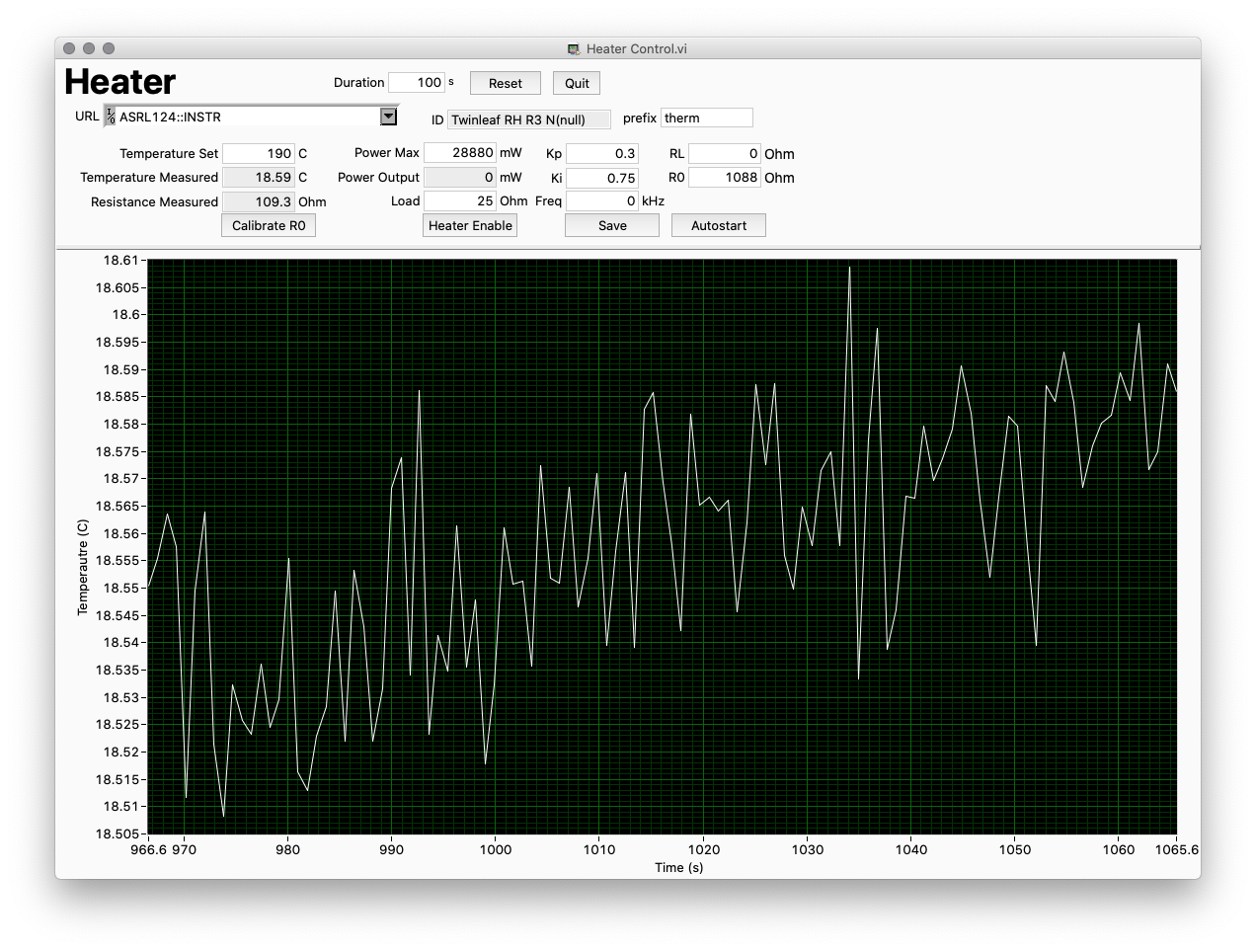TCHF Instructions
The TCHF (Temperature Control High Frequency) control unit provides reliable temperature control using high frequency alternating current that won't disrupt precision optical magnetometry measurements.
Twinleaf's TCHF controls the power of the heater rather than the voltage or amplitude. Power is related to the square root of the rms-voltage (Vrms) through the equation P = Vrms2/R.
Operation
To turn on the TCHF:
- Connect a USB device for control
- Connect a temperature sensor. Use the terminal block connections marked
therm± - Connect the heater output.
- For low heating power needs, it is possible to use the device's heater output directly from the terminal block.
- For larger devices requiring more power, connect an external amplifier to the SMB connector output.
Communication between your computer and TCHF can be done through Python or LabView.
Python Setup
Installing Python and TIO
First, install Python. Instructions for this can be found on our Getting Started With Python page.
Next, you will need to install TIO to monitor and communicate with your TCHF. Instructions for this are found on our Getting Started With TIO Python page.
Finally, it is useful to set up a proxy server so that you don't need to continuously specify the usb path when using itio and tiomon. To do this, following the tio-proxy instructions on our Getting Started With TIO Tools page.
Device Setup
Before use, it is necessary to specify a reference resistance and reference temperature related to the temperature sensor used. To do this, start communication with your device with the command:
% itio
If you do not have a proxy server running, you will need to specify the usb path here. Then, to specify your reference resistance and temperature, using the following commands:
-
Specify the sensor type using
>>> tio.tchf.therm.sensor.type(TYPE)where replacing
TYPEwith1refers to RTD and replacing with2refers to NTC thermistor. -
Set the sensor temperature coefficient using
>>> tio.tchf.therm.coef(COEF)which may be ⍺ = 0.003850 for platinum RTDs or β = 3250 for NTC thermistors obeying the Steinhart–Hart equation.
-
Set the sensor reference resistance with
>>> tio.tchf.therm.r0(RESISTANCE)where
RESISTANCEis replaced by the resistance value in Ohms. -
Set the sensor reference temperature with
>>> tio.tchf.therm.t0(TEMP)in degrees C if different from 20 C.
Setting a Temperature
To begin using your TCHF, use the following commands:
-
Set a temperature in degrees C with:
>>> tio.tchf.pid.setpoint(TEMP) -
Enable this change with
>>> tio.tchf.pid.enable(1) -
Finally, to view the output power, use
>>> tio.tchf.heater.power()
There are additional itio commands for our TCHF for more specific use (setting a maximum power, setting the heater amplitude, etc). Refer to the command line reference for additional features. To exit itio, type exit(). Finally, for a livestream of your TCHF settings and output, use the command
% tiomon
Again, the usb path will need to be specified with this command if you are not using a proxy server.
LabVIEW Setup
Twinleaf also provides a LabVIEW VI for communications with the TCHF. A screenshot is shown below.

- Select the proper USB device using the URL Dropdown Menu.
- Duration controls the time window displayed in the temperature plot.
- The Reset button resets the plot, and Quit exits the VI.
- The Temperature Set input box controls the goal temperature of the PID controlled. The measured temperature and resistance are displayed below it.
- The Calibrate R0 button sets the current measured resistance to R0 at 20 Celsius. The R0 and Calibrate Temperature can be controlled independently using the iTIO command line interface.
- The Power Max input sets the maximum wattage that the PID will output. You can adjust this below TCHF's default max, if you want to ensure a safety margin for not crossing a particular temperature. The Load setting is the resistance of the heaters.
- Kp and Ki are the P and I terms of the PID control loop, respectively. Adjustment of these parameters may cause oscillations in temperature and a prolonged settling time. Consult Twinleaf if you feel Ki and Kp should be adjusted.
- R0 is the resistance at T0, which is set to 20 Celsius by default. RL is the leads resistance, which should only be set for certain applications.
To begin heating, press the Heater Enable button. This will turn on the PID loop, which will seek to reach the temperature in the Temperature Set input box.